Going into the EURO 2020, Russia will face a difficult challenge living up to the standards they’ve set for themselves at the last World Cup. But despite having an ageing squad that heavily relies on their veterans, there are certain young players there that could give them a big boost. One such player is Rubin Kazan’s Denis Makarov, a 23-year-old winger who’s having difficulties registering meaningful game time for his country.
He wasn’t used in Russia’s latest two friendlies at all, signalling Stanislav Cherchesov doesn’t have him in his plans. But why is that so and should it change soon? This tactical analysis will give you a full scout report on Makarov while also trying to see how he could benefit Russia’s tactics at the upcoming Euros.
Player overview
Before diving into the tactics, we first have to understand what kind of a player Makarov is. At 23 years of age, he is entering his prime and represents a genuine breakout potential within Russia’s squad. Standing at 181cm, the Rubin Kazan man is technically gifted as well as being quite agile and pacey.
We’ll start the analysis by taking a look at some of his stats, which will help in identifying strengths and weaknesses. Let’s inspect the graph below.
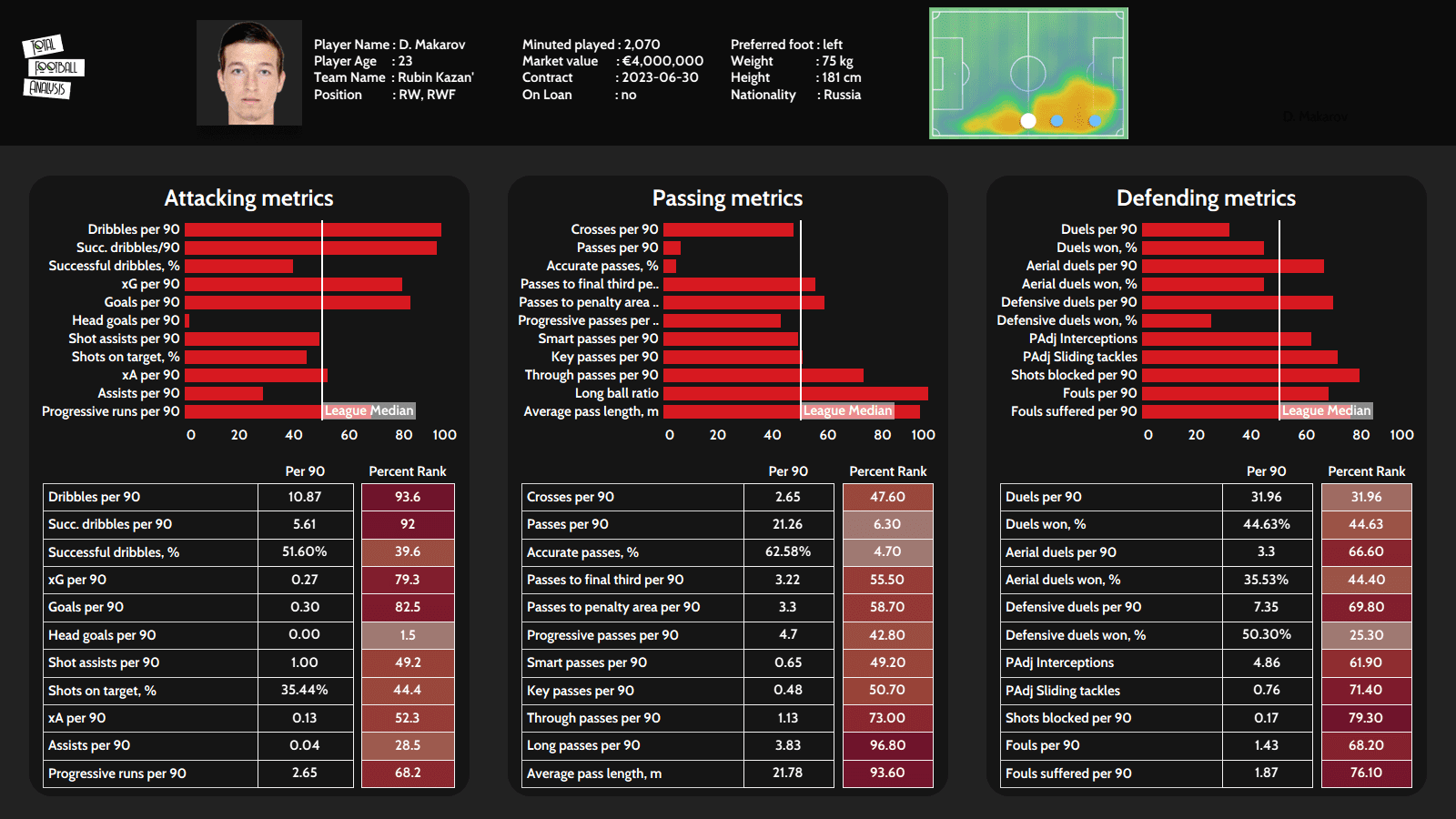
Quite clearly, he is a volume dribbler and within club football, Makarov is in the top 7% in sheer volume while still cracking the top 8% in success rate. This is undoubtedly his biggest weapon and one Russia should be using more within their tactics. But looking at expected goals and goals per 90, we can see that the 23-year-old offers quite a presence up front. Dribbles are closely connected to his progressive runs too and when combined, they form a powerful tool for advancing up the pitch.
Defensively, he is not out of this world but still decent. He engages in an above-average number of duels, both in the air and on the ground, but his success rate is not as impressive. Similarly, his pressing through PAdj (possession-adjusted) interceptions is good as well but can result in many fouls. As a great volume dribbler, he gets fouled often himself.
A clear weakness in his profile is his passing. He’s not a volume passer nor an exceptional creator. Yes, dribbling can be used to set teammates up but is mostly done to get Makarov in a good position for a long shot. The best weapon in his passing arsenal are long passes, which can be used in transitions as well as in very direct, target-man tactics.
Our tactical analysis will now dissect some of his most important traits and see whether his profile is indeed suitable for the Russian national team.
Dribbling & progression
As we’ve mentioned earlier, dribbling is Makarov’s greatest strength. Looking at his heatmap, we can see that he’s primarily positioned out wide but likes to cut inside from the right, positioning himself onto his left foot within the half-space. With 10.87 dribbles per 90 minutes last season in the Russian Premier League, he ranks fifth in sheer volume and is third in total dribbles accumulated (250).
Compared to his teammates in the national team, the situation is also clear as day. No one in Cherchesov’s current squad registers as many dribbles per 90 and only Roman Zobnin, Andrei Mostovy and Mário Fernandes boast more progressive runs from called up players. In this regard, Russia would get a massive boost on the flanks.
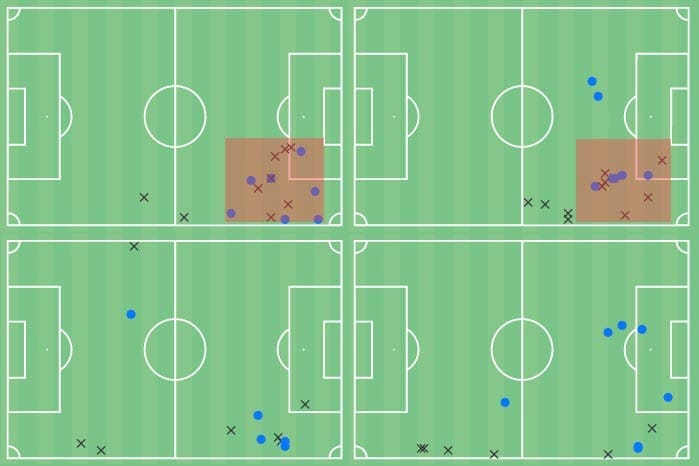
Above is a graph depicting Makarov’s dribbles in the four recent games with a big enough sample to analyse. Clearly, the 23-year-old prefers to dribble in the highlighted area just at the entrance into the final third and the right side of the box. This is also where his most successful attempts come from, which is very important for a volume dribbler.
Generally, he relies heavily on his left foot and will often do a fake shot to reposition himself, which is why he’s been compared to former Bayern Munich, Chelsea and Real Madrid star Arjen Robben. Even though the opponents know it’s coming, it’s very difficult to defend against, just as was the case with Robben terrorising Bundesliga teams back in the old days. Below is an image that will show us a more general approach to his dribbling as far as the style, location and movement are concerned.
Makarov starts the attack by cutting inside from the right wing, carrying the ball until he reaches the penalty area. Once there, he quickly changes direction, leaving the defender flat-footed and repositioning himself for a shot onto his left foot.
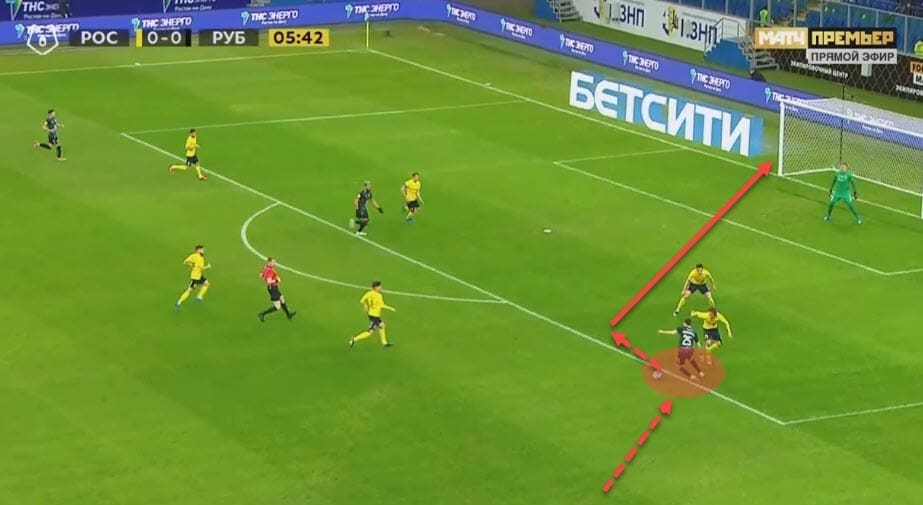
But while this is something no one in the Russian squad can offer on such a consistent and lethal basis, Makarov is not infallible when it comes to dribbling. Yes, 51.6% success rate is rather impressive but not enough to crack the top 20 in the Russian Premier League. A very big reason lies in his decision-making. Many young players struggle with deciding when and where to dribble and Makarov is no different.
If we look back at his dribbling map, we can see that most of his unsuccessful attempts come in deeper areas, which poses a problem for a risk-averse coach like Cherchesov. This is part of the reason why he may be reluctant to give Makarov more game time. There is no denying the 23-year-old has to work on this aspect of his game.
For instance, let’s look at two poor examples of decision-making when dribbling.
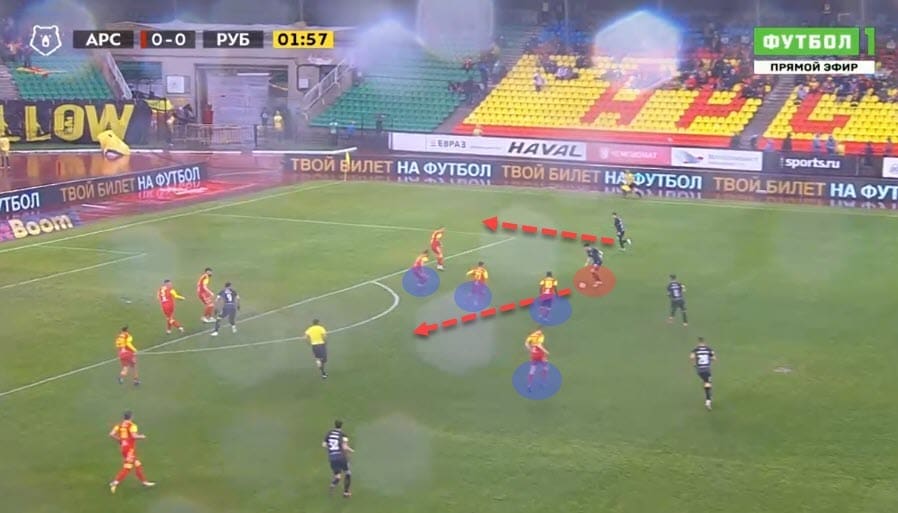
Here, Makarov is in the right half-space with enough space and time to decide his next move carefully. However, despite having a clear option out wide with the overlapping teammate, he opts to dribble into a crowd of opposition players instead. Unsurprisingly, Rubin Kazan lose the ball and the other team can burst into a dangerous transition.
His confidence is intoxicating and when it works, it’s beautiful. But when it doesn’t, it can cost his team and Cherchesov is not the type of coach to take that risk. Another example below showcases a similar scenario.
Makarov is dribbling between two players from the right side, seemingly beating both and entering the danger area. At the same time, he has a clear passing option into the box to his right.
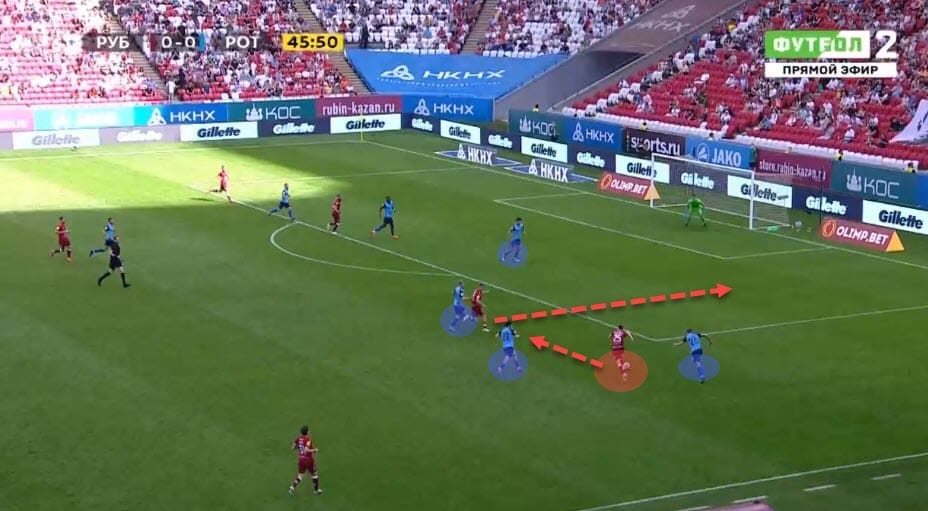
However, he opts to cut towards the more crowded area 14 once again, barging straight into two defenders and losing the ball. With 2.65 progressive runs per 90 in 2020/21, enough for the 68.2nd percentile ranking within the RPL, we see that his indeed a strength of his.
But the fact it’s still a high risk, high reward style of play may be working against the 23-year-old here. Still, his 8.1 successful attacking actions per 90 and 16.8 offensive duels per 90 are miles ahead of anyone else in the called-up Russian squad, signalling that his (more regular) inclusion would add more firepower to the lineup.
Especially since he can offer a great presence closer to the opposition’s goal too.
Shooting
Without a doubt, shooting is a huge part of Makarov’s player profile. With 79 shots in total throughout 2020/21, he ranks third in the RPL and seventh in shots per 90 (3.43). When it comes to total volume, not even the likes of Artem Dzyuba and Aleksandr Sobolev can match his output. Similarly, only the three called up strikers and Mostovoy tally more touches in the penalty area than Makarov’s 4.17 per 90 minutes.
Quite clearly, if Russia need an additional presence in the box that comes from a source other than a striker, the 23-year-old surely fits the bill. And seeing how the major brunt of their attacking firepower indeed comes from Dzyuba and Dzyuba alone, this could be a secret weapon for Cherchesov at the EURO.
Let’s analyse his shooting tendencies a bit more. Below is a graph of his last 75 shots across all competitions.
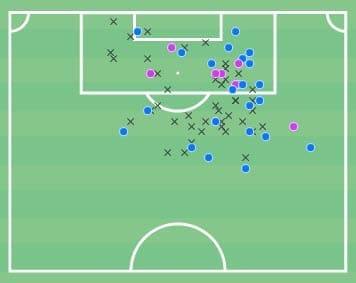
Even though the majority of his goals have come from the right side of the penalty area, the intriguing thing to see here are the long shots. 36 attempts out of his last 75 have been outside the box, 12 of which have either hit the target or rattled the inside of the net. When it comes to long shots, Makarov is third in the RPL with a total of 41 in 2020/21.
We can see his usual positioning when looking to shoot at goal in the image down below. Makarov cuts in onto his left foot and positions himself just at the edge of the box. The whole highlighted area is where he can and will make a lot of goal attempts, for better or worse.
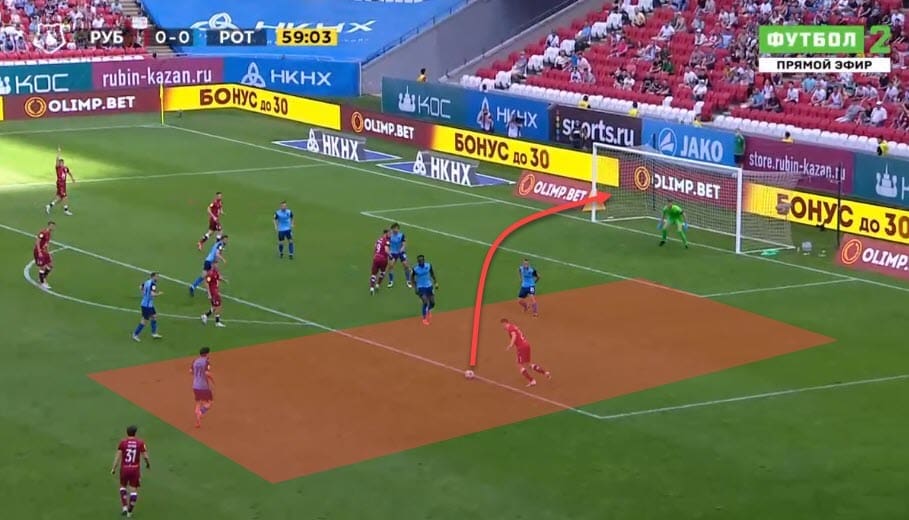
But while his shooting is certainly a big asset in his player profile, just as with his dribbling, it needs more refinement and better decision-making. Looking back at the shot location graph, we can see that despite decent accuracy in long shots, this area still has room for improvement.
Sometimes, it feels like Makarov should pass instead of letting loose and that may also be impacting his potential game time for Russia. 35.4% of his attempts end up on target, which isn’t enough to breach the top 20. In fact, it puts him just below the RPL average at the 44.4th percentile rank.
But given his exceptionally large volume of shots, this is not as surprising. So what causes his accuracy to drop so drastically? Once again – poor decision-making.
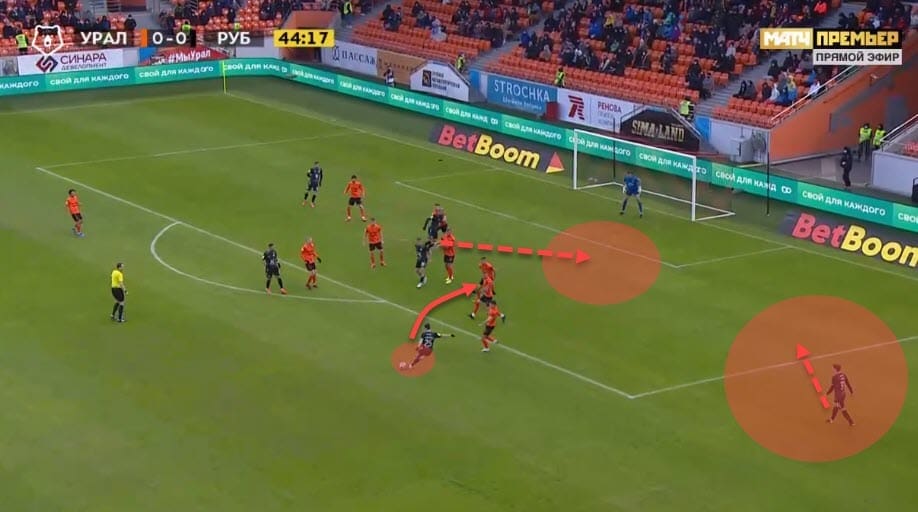
Here, we can see Makarov has two options to pass the ball into a dangerous area within the box. Instead, he opts to shoot through a crowd of opposition defenders. Unsurprisingly, the shot ends up hitting one of the players in orange, ending the attack then and there.
This is not to say Makarov should be discouraged to take these shots from long range but rather, to pick his attempts more carefully. As we’ll see later on in this scout report, he has the passing range to set his teammates up far more often. Another big weakness in his shooting is the clear preference of his left foot over the right.
In the example below, Makarov has left two defenders behind him after a great run, only to be pushed onto his right foot and completely missing the target from a promising position.
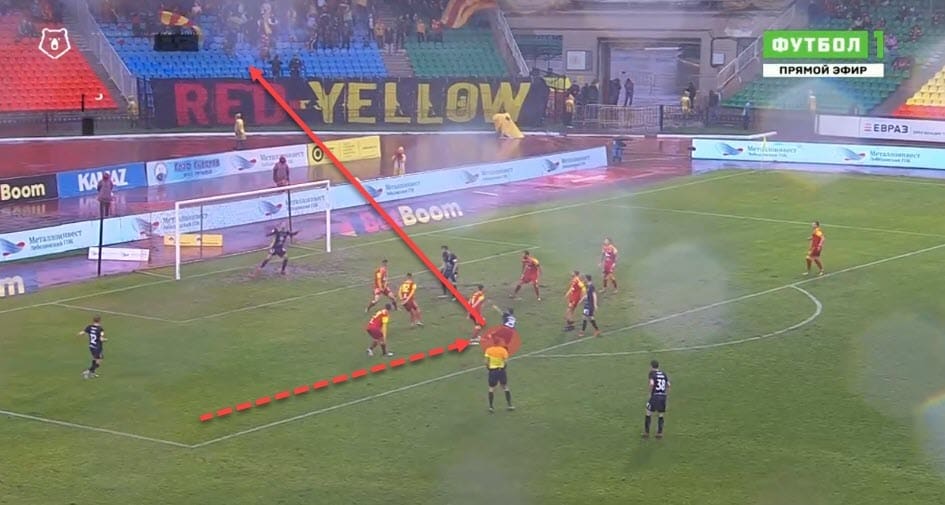
But the combination of his sheer presence in the box and the danger from both close and long range mean Russia don’t exactly have a profile like Makarov. It’s unreasonable to expect a 23-year-old youngster to be a perfectly all-rounded player with no flaws and if and when this particular one gets ironed out, he’ll ascend to a completely new level.
Long passing
The final aspect of Makarov’s profile we’ll look at in this tactical analysis is his passing. The data has made it clear this is a weakness but while he may not be a volume passer nor an excellent progressor, his range and vision can still help Russia. Cherchesov’s tactics often boil down to direct, transitional football with a big target-man in the forward line.
In that regard, short link-ups will not always be a necessity. Let’s explore three ways in which Makarov’s passing can be used to aid Russia. Firstly, Makarov has an impressive range with his long balls and can pick out distant targets with great precision.
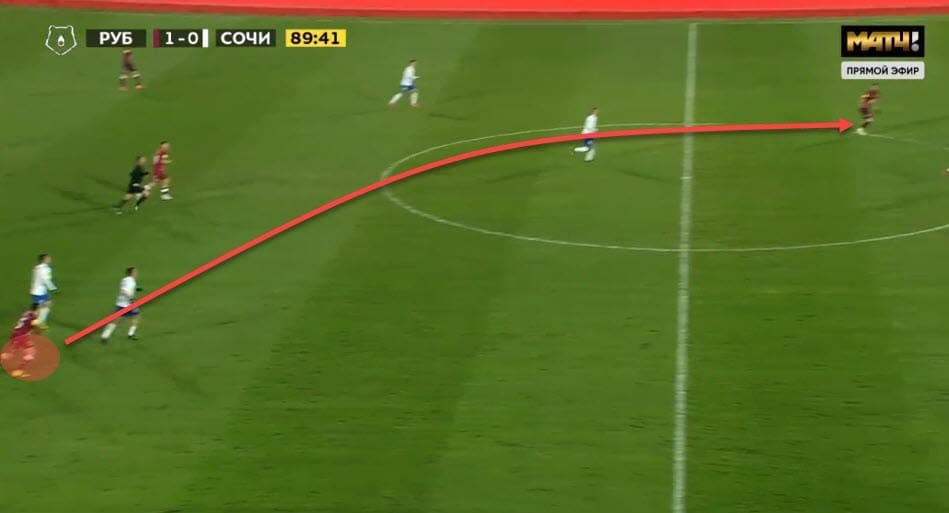
Above, you can see him do the same thing from his half all the way to the lone striker waiting for the pass. This is in line with Russia’s tendency to find Dzyuba using the same tools and having an extra player who can do this confidently would be a huge boost.
Similarly, Russia are a team that can be dangerous in transitions, often through a couple of short combinations or a simple long pass over the top, once again aimed at the strikers. Makarov is excellent at deploying those balls during counter-attacks and has the ball control and the technical ability to brush off the defenders and then deploy deadly lofted passes.
One such example can be seen below as he sends the ball into space for his teammate.
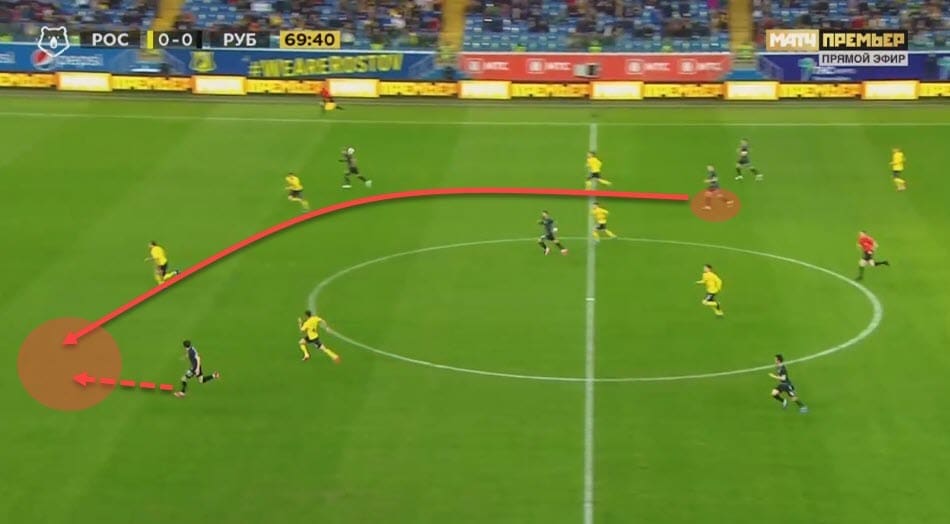
Finally, and in line with transitional tactics, Makarov’s passing is best utilised in combination with his progressive runs and dribbles. Beating a defender out wide and then creating the necessary space and time for a precise ball is also a part of his arsenal. It has to be said, however, that while he is capable of this, it’s not something we should come to expect every game.
Still, when given the opportunity and trust to do so, the 23-year-old will produce world-class passes like the one pictured below. Following a run from the deep that saw him beat his marker, Makarov identifies where his teammate needs the ball and uses the outside of his boot to thread the pass perfectly.
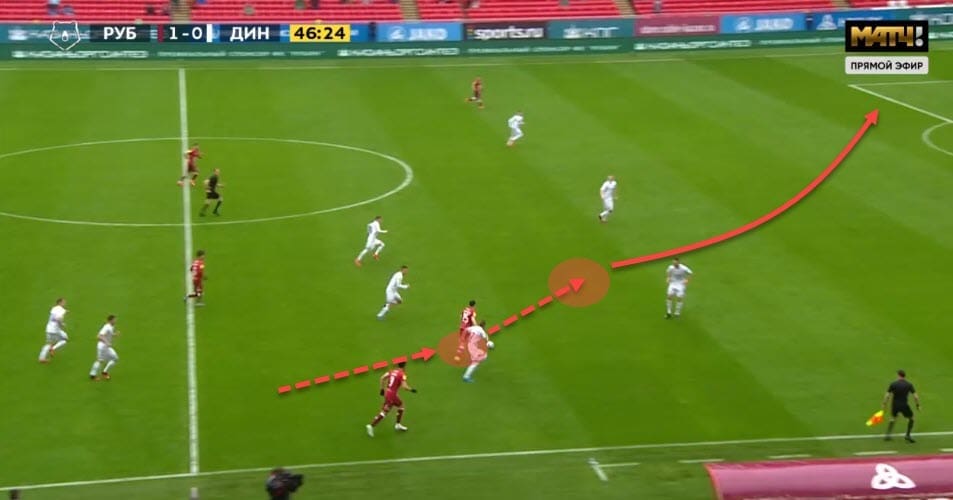
Aside from Aleksandr Golovin, there is no one else in the team with enough creative power so Makarov could ease the burden of the star midfielder. Adding him would not immediately solve this problem either but would be a step in the right direction, both in terms of developing his profile and fixing the team’s struggles.
Conclusion
Hopefully, this tactical analysis has shed some light on Denis Makarov’s profile while simultaneously highlighting some of the issues that may be standing between him and more regular game time in the national team. Cherchesov is a coach heavily set in his ways and leaning towards a more risk-averse approach to games.
With that in mind, it’s easy to discern adding a highly volatile and unpredictable profile such as Makarov would likely destabilise his game plan. And it’s also Cherchesov’s lack of innovation and experimentation with the structure that is keeping Makarov chained to the bench.
Russia’s preferred 4-2-3-1 (51% in the last calendar year), 3-4-2-1 (15%) and 3-5-2 (12%) systems leave Makarov’s favourite wide positions always occupied by fixed starters and non-negotiable presences in the gala roster. For now, Makarov can’t hope to displace Golovin or Miranchuk and deploying him as a wingback might be a waste of his attacking presence so the best he can hope for is to be a super-sub from the bench.
Arguing that the 23-year-old should be a starter is difficult at this point, under this coach and such a rigorous system but the lack of game time is still criminal on Cherchesov’s part. The sheer dynamism and change of pace Makarov’s introduction to the squad would offer heavily outweighs the negatives.
There are still flaws in his profile that need to be fixed but for a team struggling for attacking power and diversity in the forward line, Russia should definitely turn to the young winger far more often.






Comments